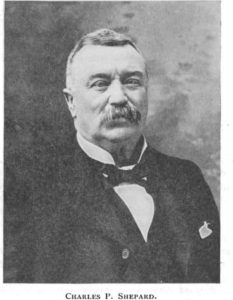
The Town of Boscawen had ten (10) United States Sharpshooters in the Civil War. To be a Sharpshooter you had to put ten bullets in succession within a ten-inch circle at 200 yards at rest, and another ten at 100 yards off hand. You could go off to war with your own gun, but our Boscawen boys were promised better. Hiram Berdan was an engineer, military officer, world-renowned marksman, and the guiding force behind the famed United States Sharpshooters during the Civil War. When Berdan recruited the Sharpshooters from NH, they were promised Sharp rifles. When Ichabod Goodwin, Governor of New Hampshire inspected his troops, and found they had not received their Sharp rifles, he threatened to pull his Sharpshooters from the conflict. In May 1861, as the Civil War began, Goodwin responded to the first calls for soldiers by borrowing funds against his own name to equip two regiments. The NH Legislature affirmed the Governor’s action when they came into session the following month.
Charles Pearson Shepard was one of Boscawen’s Sharpshooters. He came from a family with an extensive military history. The son of Jonathan C. and Almeda (Pearson) Shepard was born on February 26, 1842, in Grafton, NH. His great-grandfather, Daniel Shepard, went along with other Boscawen soldiers to Lexington, at the outbreak of the Revolution, where he was wounded. Daniel also trekked with General Stark over to Bennington for other action. Daniel’s father was involved in the skirmishes of the French & Indian war, in 1757-59 – the one that gave Boscawen its name change from Contoocook Plantation after the Battle of the Plains of Abraham in Quebec City; and turned what is now Canada into English-administered lands.
Charles Pearson Shepard enlisted on August 30, 1861, Company E. He was shipped to the front immediately, near Richmond, Virginia, where he lasted until July 1, 1862. At the Battle of Malvern Hill on the last day of a seven-day engagement, Charles was wounded.; shot through the abdomen by a Minié Ball. During the Civil War both the North and South used this rifle-musket, muzzle-loading, spin-stabilizing rifle bullet. It was one of the Civil War’s deadliest weapons on both sides of the conflict. The ball went straight through his body, “Letting the daylight shine through me.”
Charles did not fall immediately, but two comrades carried him bak out of action, leaving him for dead. At the battlefield hospital, he was examined and placed with the mortally wounded. The next morning, “It rained hot water,” and he believed that was what saved his life. Using his musket as a crutch, he started out for “God’s Country,” all by himself.
After traveling three miles, Charles met a wagon master that he knew from Canterbury – yes, the Canterbury across the river. This kind soul found him a place in an ambulance and gave him a tot from the flask he carried. The ambulance took Charles to an ambulance boat on the James River, bound for Washington DC. “They were packed in like sardines in a box.” He was stripped of his clothing, money, and all his possessions, and then he became unconscious of anything more until he reached Washington. When he came to, he found himself left alone naked, as dead.
Charles thinks it was July 4th morning that brought him to life again. He crawled out of the boat, started for better quarters, and soon met two government clerks. They proved to be Good Samaritans, indeed. They put him on a stretcher, covered him with some of their own clothes and carried him off to a church which was used as a hospital. They then placed him in the care of doctors and nurses, and also wrote home for him, informing his parents that he was mortally wounded. The manager of the hospital reported his case to the Surgeon General, who had Charles moved to an officer’s hospital in Georgetown, D.C.
Charles was treated there for four months until he was able to travel. He was honorably discharged on October 6, 1862 for disability, and returned home. He married twice, in 1871 to Martha Webster of Center Harbor, and they had two daughters. She died in 1876. In 1882 he married Carrie J. Evans of Manchester. She died in 1897, leaving no children.
Later in life, he was gored in the leg by a bull. It was more than a year before he could use the leg again. Even then the good Lord wasn’t ready for Charles Pearson Shepard of Boscawen, NH, one of Berdan’s Sharpshooters.
Charles died on May 1, 1922 ae 80 yrs, 2 mo, 5 days, and is buried in the Plains Cemetery, along with several other of the Boscawen Sharpshooters.
The Other Nine Civil War Sharpshooters From Boscawen were: James W. Bent, Jonas T. Boynton, Edwin H. Chadwick, Daniel Morse, Benjamin Morrison, Henry Pearson, Calvin W. Simonds, Nathaniel Thurston, and James S. Tyler.
At Gettysburg Hiram Berdan reported that during the three-day battle the Sharpshooters had 450 rifles that shot 14,400 rounds of ammunition.
Sources: